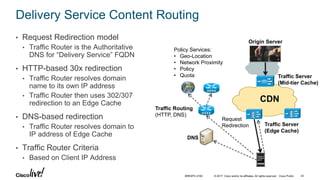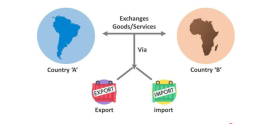
How CDN Traffic Routing Ensures Efficient Content Delivery
“`html
Imagine you’re sitting down to watch your favorite show online, and you’re ready to binge on the latest episodes. You curl up on the couch, popcorn in hand, but as you hit play, what happens? The dreaded buffering symbol takes over the screen, stealing away your excitement. Frustrating, right? This evening doesn’t have to be a nightmare! Many of us have experienced the agony of slow streaming or the disappointment of websites that just don’t load. You may have even wondered, “Why does this happen?” You’re not alone.
In a world where everything is fast-paced and instant, we all crave immediate access to content. Fortunately, there are systems designed to ensure that you get the content you need without all the fuss—the Content Delivery Network (CDN) and its traffic routing is one of those systems. By understanding how CDN traffic routing works, you can minimize those annoying interruptions and make your online experience seamless.
In this article, let’s dive deep into how CDN traffic routing ensures efficient content delivery. We’ll tackle common obstacles you might face while online and explore practical solutions that technology offers today. Whether you’re an avid streamer, a casual browser, or someone running a website, understanding CDN can help you unlock a smoother digital experience.
What is a CDN?
A Content Delivery Network is a system that delivers your content—from videos to websites—faster and more efficiently. Think of it as a network of friendly delivery people spread across various locations. Instead of relying on a single delivery route, CDNs use multiple pathways to ensure your packages arrive promptly and securely.
How Does CDN Work?
When you access content online, your request is directed to the nearest server in the CDN. This method reduces latency—the delay before the transfer of data—because the data doesn’t have to travel halfway around the world to reach you. Instead, it travels a shorter distance, allowing you to enjoy what you want with minimal delay.
The Importance of Traffic Routing
At the heart of a CDN’s efficiency lies traffic routing. Think of it like a GPS for data. Just as your GPS finds the quickest route to avoid heavy traffic, CDN routing identifies the best path for your content—a critical factor impacting your browsing experience.
How CDNs Optimize Routing
CDNs optimize routing through various techniques, including:
- Geolocation-Based Routing: This approach directs users to the nearest server based on their geographic location.
- Load Balancing: Distributing user requests across multiple servers to prevent any single server from becoming overloaded.
- Smart Steering: Utilizing real-time data to determine the best routing path depending on current network conditions.
Challenges Solved by CDN Traffic Routing
Now that we understand how CDN and traffic routing function, let’s talk about the real-world challenges addressed by these technologies.
Reducing Latency
Latency can ruin your digital experience. With effective traffic routing, CDNs minimize latency and ensure speedy content delivery. Think about it like a relay race; the baton (data) must travel the shortest distance with the least resistance for the team (your computer) to win the race.
Improving Load Times
Slow load times can directly impact user experience, leading to frustration and even disengagement. By having multiple servers and smart routing mechanisms, CDNs ensure that content loads quickly and efficiently, regardless of what you’re accessing—be it a website or a video stream.
Enhancing Reliability
Have you ever lost connection during an important live event? CDNs provide redundancy. If one path is blocked, traffic can be rerouted through another, ensuring that you stay connected and content is delivered effectively. This reliability is essential for businesses that need to maintain their online presence without interruptions.
Security Features of CDN Traffic Routing
In addition to speed and efficiency, security is another pivotal role that CDNs play in traffic routing. The safety of online data is a growing concern with cyber threats everywhere.
Protection Against DDoS Attacks
CDNs help thwart Distributed Denial of Service (DDoS) attacks by distributing incoming traffic across many servers. This dispersion makes it harder for attackers to overwhelm any single server, providing an additional safety net for users and businesses alike.
Improved Content Security
With encryption and secure data transfers, CDNs ensure that your sensitive information remains protected as it pipes through various routers and servers. This level of security gives peace of mind, knowing that your personal data is shielded.
Expert Insights on CDN Effectiveness
Industry experts agree that CDN technology is only going to become more essential as internet usage grows. According to a report from content delivery experts at Akamai, “the reduction of latency can significantly improve user satisfaction and customer retention.” In simpler terms, a faster, smoother online experience leads to happier users.
Case Study: How a Major Retailer Benefited from CDN
To illustrate the practical application of CDN traffic routing, consider a case study of a major retailer, DarazHost. After facing problems with site speed and a high bounce rate (when users leave a site quickly), they implemented a CDN. Beyond a 40% increase in page loading speed, the retailer also reported a 45% decrease in bounce rate.
Results Achieved
Thanks to CDN traffic routing, DarazHost successfully managed to deliver a smoother shopping experience, solidifying their customer base and increasing sales by 15% in just a few months. This successful application highlights the critical importance of investing in reliable CDN services.
FAQs
What is the main purpose of a CDN?
The main purpose of a CDN is to deliver content quickly, efficiently, and securely to users worldwide, minimizing latency and enhancing the overall experience.
How does CDN traffic routing work?
CDN traffic routing works by directing users to the nearest server in the network based on their location, optimizing the route for faster content delivery.
Can a CDN improve website security?
Yes, a CDN can improve website security by providing features such as DDoS protection and encrypted data transfers, helping to secure sensitive information.
Is CDN only for large companies?
No, CDNs are beneficial for businesses of all sizes, including small and medium businesses that want to enhance their online presence and content delivery.
How can I choose the right CDN provider?
When choosing a CDN provider, consider factors such as server locations, pricing, security features, and customer support to find one that meets your needs.
What impact does latency have on user experience?
Latency can negatively impact user experience, leading to slower load times and potential disengagement if content takes too long to appear.
How does a CDN reduce buffering for videos?
A CDN reduces buffering times for videos by delivering them from the nearest server, ensuring that the data reaches viewers quickly and smoothly.
What are The key benefits of using a CDN?
The key benefits of using a CDN include faster content delivery, reduced latency, improved load times, enhanced website reliability, and added security features against cyber threats.
understanding CDN traffic routing is essential for optimizing your online experience. Whether you’re streaming your favorite show, browsing your favorite website, or managing a business’s online presence, the right CDN can make all the difference. With the increase in internet usage and rising expectations for content delivery speed, investing in a reliable CDN is not just beneficial, it’s essential for staying competitive in today’s digital landscape.
“`









